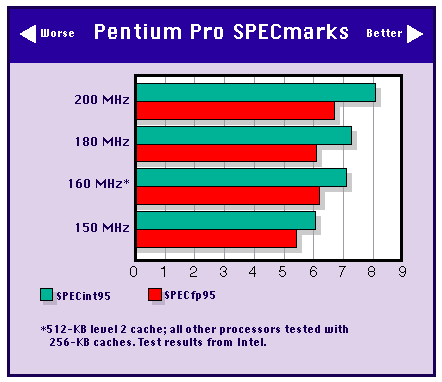| Speed freaks rejoice: Faster versions of the Pentium Pro
have appeared sooner than expected. Intel originally
planned to introduce the new microprocessor at 133 MHz,
but the low end turned out to be 150 MHz, and Intel is now
producing chips that run at 200 MHz. At this rate, the
Pentium Pro should hit 250 MHz by year end. Three factors account for this progress: the Pentium Pro's superpipelined design; better-than-expected results from early silicon; and Intel's massive investment in new wafer-fabrication plants. All modern microprocessors pipeline their instructions, a RISC technique. Like a factory assembly line, pipelining breaks processing into stages, and the CPU operates on several instructions at once with each instruction at a different stage of completion. Superpipelining uses more and shorter stages; it's like an assembly line where each worker's task is simplified. Because it takes less time to complete each stage, superpipelined CPUs can run at higher clock speeds, which yields greater instruction throughput. While most CPUs have pipelines five to seven stages long, the Pentium Pro has a 14-stage pipe. Although longer pipelines extract greater penalties when the CPU mispredicts a branch, most instructions execute faster, and the Pentium Pro's branch prediction is more than 90 percent accurate, according to Intel. Superpipelining with shorter, less-complex stages is the reason why the Pentium Pro will always run at higher clock speeds than the five-stage Pentium chip, even when both chips use the same process technology. Nevertheless, process technology plays a major role, too. Intel makes the 150-MHz Pentium Pro on an older 0.6-micron process, but the 166-MHz and faster versions use Intel's new 0.35-micron technology. Signals flow more quickly through the more densely packed circuits, permitting higher clock speeds. In 1995, Intel became the first company to manufacture CPUs in volume on a 0.35-micron process, and Intel is outspending everyone on new fab capacity. To boost performance even further, Intel is also making some Pentium Pro processors with 512-KB secondary caches built into the package. That's twice as large as the 256-KB caches originally introduced. The accompanying SPECmark numbers show the result: A 166-MHz Pentium Pro with a 512-KB cache virtually matches the performance of a 180-MHz Pentium Pro with a 256-KB cache. (The 166-MHz version of the chip also has a faster memory bus — 66 MHz versus 60 MHz for the 180-MHz Pentium Pro.) Higher clock speeds and bigger caches will compensate for the Pentium Pro's relatively poor performance when running older 16-bit software. Although a fifth-generation Pentium still outperforms a sixth-generation Pentium Pro when running 16-bit code at similar clock speeds, the fastest Pentium currently tops out at 166 MHz. Future Pentiums may get a little faster, but they will never catch up to the Pentium Pro's really high clock frequencies. Pentium Pro Lineup

Pentium Pro SPECmarks
Copyright 1994-1998 BYTE |